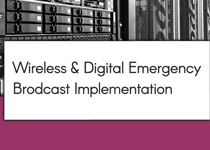Opencode Cell Broadcast eXpander (iCBX) - an early warning system with an outstanding reach
An early warning system is a fast, wide-reaching communication tool that enables particular local, regional, or national authorities to send alerts or important notifications to segments of or the whole population with information about an imminent danger or an ongoing emergency.
Implementing an early warning system based on Cell Broadcast (CB) is not something revolutionary new. In fact, Cell Broadcast (CB) was first demonstrated in Paris in 1997, while the technology as an early warning tool gained traction and enjoyed increasing interest from governments after the devastating Indian Ocean Tsunami in 2004.
Since then, numerous governments from all over the world are striving to implement, renew, and modernize their national early warning system, in order to guarantee a swift and dependable disaster management for their country.
So, how does Opencode Cell Broadcast early warning system operate, what is its potential reach with the Cell Broadcast eXpander, and how does it manage to cover as much of the affected population as possible? Find out in the following paragraphs.
What is an early warning system used for?
The case studies of utilizing a steadfast early warning system are potentially unlimited. Governments and their respective authorities responsible for alerting the population can use the Opencode Cell Broadcast early warning system during various events, such as:
- Early warning system for expected or ongoing weather emergencies, such as hurricanes, tornadoes, fires, floods, or severe temperature disruptions;
- Early warning system for foreseeable or current geological disasters, such as earthquakes, tsunamis, volcanic eruptions, or massive landslides;
- Early warning system for medical emergencies, such as epidemic or pandemic outbreaks, infectious disease spread, or quarantine measures;
- Early warning system for industrial accidents, such as air or water contamination, nuclear disasters, or stock poisoning;
- Early warning system for security reasons - military invasions, incoming missile warnings, terrorist attacks, bombings.
A Cell Broadcast-based early warning system is intended to give short and clear instructions or guidance for all citizens that are located in the affected area, which could range from a small village to the territory of the whole country. In doing so, the early warning system can help people take adequate decisions and life-saving measures that could significantly improve their overall safety and survivability chances. The early warning system could also be used to provide information about emergency events and reassure the population that the emergency services are taking the situation under control, thus avoiding unnecessary panic and fear.
How does an early warning system operate: the basics
Essentially, the early warning system based on a cell broadcast technology is designed to deliver rapid emergency alerts to all mobile devices based in or entering a particular geographical region.
The Cell Broadcast early warning system alerts are directly broadcast by the radio infrastructure of the mobile operators - they bypass the core network and go straight to the mobile cells in the affected area and from there are disseminated to all mobile devices within the cells' range .
Opencode Cell Broadcast-based early warning system is developed and functions within the rules laid down by several emergency alert standards. These include CMAS, EU-Alert, ETWS, WEA. Of course, our early warning system supports the Automatic Terminal Information Service (ATIS) as well as the XML-based Common Alerting Protocol (CAP).
Opencode iCell Broadcast early warning system is compatible with all networks and handheld devices, thus producing no exclusion of citizen groups when delivering vital disaster management information. All that being said, the Opencode iCell Broadcast early warning system bestows a last-generation, intelligent, and trustworthy solution for managing an ongoing crisis all around the globe.
What is the standard reach of the Opencode iCell Broadcast early warning system?
Opencode iCell Broadcast early warning system delivers messaging through the MNO - the conventional cell broadcast channel of the mobile network operators, also known as wireless communications services.
Generally, the communication path of a unified early warning system starts from a system managing device, goes from a cell broadcasting system to the radio infrastructure (BSC/RNC/MME/AMF) of the mobile operators, and then heads to a set of predetermined locations.
The messages sent out by an early warning system are very similar to flash SMS messages - they may include up to 1395 characters written in Chinese, Arabic, Latin, Cyrillic, and Devanagari symbols, while additional early warning system languages can also be implemented for our clients on demand.
How does the iCell Broadcast eXpander broaden the early warning system reach?
When implementing the iCell Broadcast eXpander, added to the the Opencode iCell Broadcast early warning system, the emergency alerts distributed by authorities can be issued over a set of extra channels, such as:
- Direct SMS;
- Radio;
- Digital TV;
- Sirens;
- Public digital boards and signages;
- Social networks, and more.
The path of the multichannel early warning system support includes mobile base stations, SMS Centers, Radio, TV and Mobile Apps, as well as transport and infrastructure agencies.
As an ultimate result, the boosted early warning system provides an outstanding reach. It becomes easily noticeable by the general public, even if some members of society do not currently own, use, or have immediate access to a handheld mobile device.
Learn all about our early warning system, straight from the source
The early warning system of Opencode manages various additional extras and management options. Our variable early warning system communication parameters include message ID, SN, cell IDs, repetition interval and rates, coding scheme, content type, splitting, priority, and many others.
To discover, examine, and understand more in-depth technical specifications of the Opencode iCell Broadcast early warning system, you can keep exploring our business website, download some of our commercial brochures, or simply reach out to our team and let us discuss your particular case.
Our devoted team of over professional 200 engineers is currently assisting with early warning system and new generation core network technologies in over 50 countries worldwide. Some of our governmental and telecommunication clients' locations include countries like the USA, Canada, Greece, Vietnam, Germany, and tens of others.
We would be more than happy to make you part of our next early warning system success story, and we will do our best to provide you with all the valuable info on our early warning system you might need to make a thoroughly informed decision.
Opencode iCell Broadcast & eXpander - employing an early warning system with outstanding reach
What is an early warning system used for?
How does an early warning system operate: the basics
What is the standard reach of the Opencode iCell early warning system?
How does the iCell Broadcast eXpander broaden the early warning system reach?
Learn all about our early warning system, straight from the source













